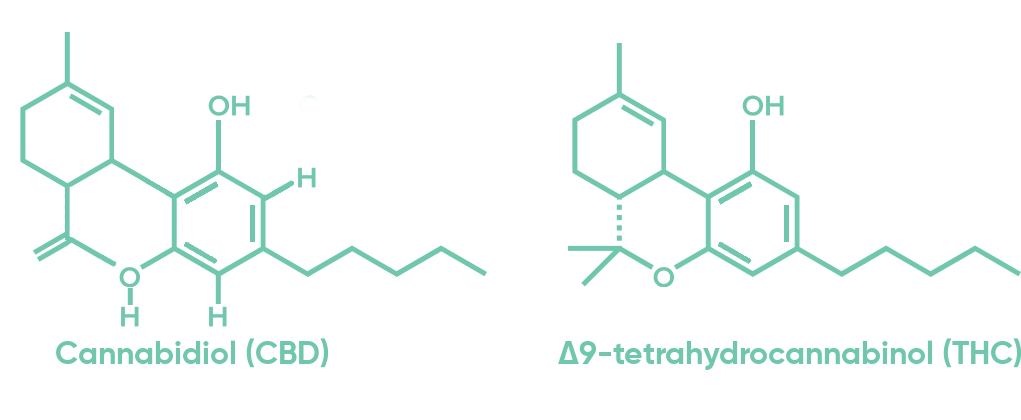Chemistry: cannabis compounds
Cannabis plants can produce a variety of effects, which is based on their chemistry, i.e. chemical makeup of cannabis compounds (cannabinoids and terpenes) that differ per variety, {call-out, text:Cannabis plants have different varieties\, just like there are different varieties of apple trees\, for example} also referred to as a “strain.” The chemicals in cannabis exert their effects on the body by interacting with the
endocannabinoid system (ECS).
1 The endocannabinoid system is responsible for regulating an array of physiological and cognitive processes that have been studied in humans and animals, including appetite, pain-sensation, mood, memory,
2, 3 fertility,
4 pregnancy,
5 and pre- and postnatal development.
6
The ECS is composed of two kinds of
receptors {call-out, text:Binding places in the body where physical and mental effects take place after compounds bind to them}: the cannabinoid receptor type 1 (CB
1) and the cannabinoid receptor type 2 (CB
2). The CB
1 receptors are located primarily in the
central nervous system {call-out, text:The brain and the spinal cord}, most of them being concentrated in the brain.
1 The CB
2 receptors are located primarily in the
peripheral nervous system {call-out, text:All the nerves outside of the brain and the spinal cord}.
1 The chemicals in cannabis bind to these receptors to exert their effect.
There are two main groups of chemicals in cannabis –
cannabinoids and
terpenes. Cannabinoids are compounds that interact with receptors found all over our bodies. Below are illustrated two most-well known cannabinoids, cannabidiol (CBD) and Δ9-tetrahydrocannabinol (THC). These compounds are typical for the cannabis plant, although some of them can be found in other plants. Terpenes are compounds that create the smell and taste of the plant and can induce effects on their own, as well as influence effects by cannabinoids. Cannabis contains other compounds besides cannabinoids and terpenes. Brenneisen et al. in their publication discuss the compounds found in cannabis. Besides cannabinoids and terpenes, they also list hydrocarbons, nitrogen-containing compounds, carbohydrates, flavonoids, fatty acids, noncannabinoid phenols, alcohols, and esters, as well as many others.
7 In 2016, Aizpurua-Olaizola et al. identified 554 compounds in cannabis, including 113 cannabinoids and 120 terpenes.
8

- Fine, Perry G.; Rosenfeld, Mark J. (2013). The Endocannabinoid System, Cannabinoids, and Pain. Rambam Maimonides Medical Journal, 4(4), e0022.
- Aizpurua-Olaizola, Oier; Elezgarai, Izaskun; Rico-Barrio, Irantzu; Zarandona, Iratxe; Etxebarria, Nestor; Usobiaga, Aresatz (2017). Targeting the endocannabinoid system: future therapeutic strategies. Drug discovery today, 22(1), 105--110.
- Donvito, Giulia; Nass, Sara R.; Wilkerson, Jenny L.; Curry, Zachary A.; Schurman, Lesley D.; Kinsey, Steven G.; Lichtman, Aron H. (2018). The Endogenous Cannabinoid System: A Budding Source of Targets for Treating Inflammatory and Neuropathic Pain. Neuropsychopharmacology, 43(1), 52--79.
- Klein, Carolin; Hill, Matthew N.; Chang, Sabrina C. H.; Hillard, Cecilia J.; Gorzalka, Boris B. (2012). Circulating Endocannabinoid Concentrations and Sexual Arousal in Women. The journal of sexual medicine, 9(6), 10.1111/j.1743--6109.2012.02708.x.
- Wang, Lei; Liu, Jie; Harvey-White, J.; Zimmer, Andreas; Kunos, George (2003). Endocannabinoid signaling via cannabinoid receptor 1 is involved in ethanol preference and its age-dependent decline in mice. Proceedings of the National Academy of Sciences, 100(3), 1393--1398.
- Fride, E.; Suris, R.; Weidenfeld, J.; Mechoulam, R. (2005). Differential response to acute and repeated stress in cannabinoid CB1 receptor knockout newborn and adult mice. Behavioural pharmacology, 16(5-6), 431--40.
- Brenneisen, Rudolf (2007). Chemistry and analysis of phytocannabinoids and other Cannabis constituents. Marijuana and the Cannabinoids (17--49). Springer.
- Aizpurua-Olaizola, Oier; Soydaner, Umut; Ozturk, Ekin; Schibano, Daniele; Simsir, Yilmaz; Navarro, Patricia; Etxebarria, Nestor; Usobiaga, Aresatz (2016). Evolution of the Cannabinoid and Terpene Content during the Growth of Cannabis sativa Plants from Different Chemotypes. Journal of natural products, 79(2), 324--331.
 References:
References:_logo.svg)